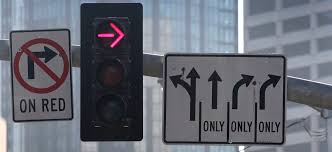In a move to enhance pedestrian safety and improve urban traffic flow, transportation authorities across the United States are considering phasing out the long-standing practice of allowing right turns on red lights in urban areas. This proposed change could bring significant shifts to city streets, affecting motorists, pedestrians, and cyclists alike.
The History of Right Turns on Red
The practice of permitting right turns at red lights was widely adopted in the 1970s as a fuel-saving measure during the energy crisis. It allowed vehicles to keep moving instead of idling, reducing fuel consumption and emissions. Since then, right-on-red rules have become a common feature of traffic systems across the country, with exceptions in states like New York, where urban areas such as New York City have long prohibited the practice.
While convenient for drivers, right-on-red has faced criticism for creating conflicts between vehicles and vulnerable road users, such as pedestrians and cyclists. Recent data indicates that a significant number of traffic accidents at intersections involve vehicles turning right on red, prompting officials to reassess its viability in increasingly congested urban environments.
Why the Change is Being Proposed
The push to phase out right turns on red stems largely from a growing emphasis on Vision Zero, a global initiative aimed at eliminating all traffic fatalities and severe injuries while ensuring safe and equitable mobility for all. Cities like Washington, D.C., and San Francisco, which are actively pursuing Vision Zero goals, have already restricted right-on-red at many intersections.
A study conducted by the National Highway Traffic Safety Administration (NHTSA) revealed that right turns on red contribute to a significant percentage of pedestrian injuries at intersections. Additionally, the rise of micromobility solutions like e-scooters and shared bikes has complicated the dynamics at intersections, making it more dangerous for non-motorized users to navigate crossings.
“Pedestrian safety must come first,” said Dr. Elena Martinez, a traffic safety expert at the University of Michigan. “Eliminating right turns on red is a simple but effective step toward reducing conflicts at intersections.”
Cities Leading the Charge
Several cities have already taken proactive measures to curb or ban right turns on red. For instance:
- Washington, D.C. has restricted the maneuver at over 100 intersections and plans to extend the ban citywide by 2025. The city’s Department of Transportation reports a marked decrease in pedestrian-related crashes in areas where the ban is in place.
- San Francisco has implemented no-turn-on-red rules in high-traffic areas as part of its Vision Zero efforts, emphasizing the importance of reducing risks for pedestrians and cyclists.
- Portland, Oregon, known for its progressive urban planning, is also exploring a citywide ban following a pilot program that showed reduced conflicts at intersections.
These cities cite early successes, including fewer accidents, calmer traffic, and improved pedestrian flow.
Public Opinion and Concerns
The proposed changes have drawn mixed reactions from the public. Advocates for pedestrian and cyclist safety have largely supported the idea, arguing that the benefits far outweigh the inconvenience to drivers.
“Right turns on red make intersections unsafe for everyone who isn’t in a car,” said Sarah Green, a member of the nonprofit advocacy group WalkSafe America. “This change would save lives.”
However, some drivers and business owners have expressed concerns about potential downsides, including increased traffic congestion and longer commutes. Delivery drivers, in particular, worry that eliminating right turns on red could slow down routes in already congested urban cores.
To address these concerns, transportation experts recommend coupling the ban with other measures, such as optimized traffic signal timing and the introduction of dedicated right-turn lanes at intersections.
What Comes Next?
The proposal to phase out right turns on red is still in its early stages in most cities, with policymakers focusing on pilot programs and data collection to assess the impact of such measures. Local governments are also working to ensure public awareness of the potential changes.
Some states may require legislative amendments to traffic codes before a citywide or statewide ban can take effect. The Federal Highway Administration (FHWA) has emphasized that local governments should rely on data-driven decision-making when implementing such policies.
For motorists, this potential change underscores the importance of staying informed about new traffic rules and regulations. City-specific traffic updates can be accessed via local transportation department websites, such as the San Francisco Municipal Transportation Agency or District Department of Transportation.
The Bigger Picture: Prioritizing Urban Safety
Beyond the immediate safety benefits, eliminating right turns on red aligns with broader efforts to create more livable and pedestrian-friendly cities. Urban planners argue that reducing vehicle dominance at intersections can encourage walking, cycling, and the use of public transit, contributing to lower emissions and healthier communities.
“Phasing out right-on-red signals that cities are prioritizing people over cars,” said Mark Lopez, an urban planning consultant. “It’s a step toward reclaiming streets for everyone, not just motorists.”
As cities across the nation grapple with rising traffic fatalities and the challenges of dense urban environments, the move to end right turns on red is part of a larger conversation about redefining mobility in the 21st century.
Conclusion: A New Era for Urban Intersections
While the elimination of right turns on red may require an adjustment period for drivers, the potential benefits for pedestrian safety and traffic flow are compelling. Cities experimenting with these changes are already seeing promising results, setting the stage for a possible nationwide shift.
As these discussions continue, citizens are encouraged to participate in public hearings and stay informed about proposed changes in their local areas. For updates and information on traffic safety initiatives, visit the National Highway Traffic Safety Administration or your city’s transportation department.
The phasing out of right turns on red could mark a turning point in how urban areas balance mobility and safety, ensuring that everyone—pedestrians, cyclists, and drivers—shares the road equitably and responsibly.
Disclaimer – Our team has carefully fact-checked this article to make sure it’s accurate and free from any misinformation. We’re dedicated to keeping our content honest and reliable for our readers.








